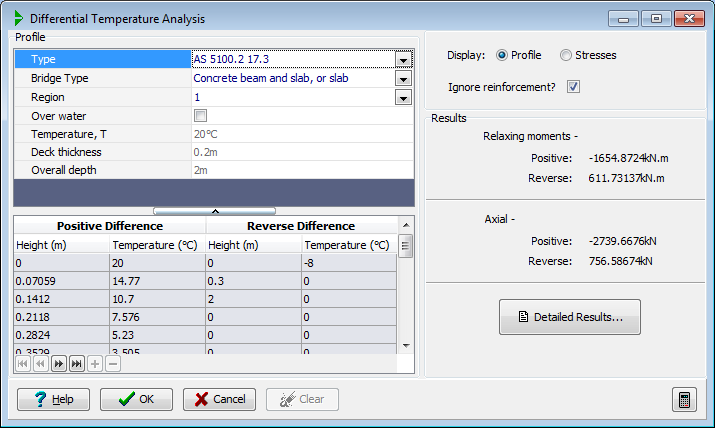Differential Temperature Analysis
Description
This form allows positive and reverse temperature profiles to be specified by either selecting the standard type or by explicit definition. The temperature profile through a bridge deck for different types of construction are given in Clause 2/18.3 of AS 5100.2-2017 for surfacing of up to 50mm thickness.
Once the profiles are defined, a comprehensive series of data checks are carried out before the calculations are performed and the results displayed.
Outline Procedure
The temperature profile can be generated when the Display radio button is set to Profile by specifying only: the bridge type and region; whether the structure is over water; and for steel superstructures, the thickness of the concrete slab. The table shows the values generated, and the graphics show the positive and reverse temperature profiles drawn to scale.
The table cannot be edited unless the profile type is switched to the User Defined type. With the User Defined type selected, the temperature may be specified at up to 20 heights through the section, including the top and bottom surfaces.
When the Display radio button is set to Stresses, the stress profiles are displayed graphically, and the principal values are displayed. More detailed results are available in the printout, which can be viewed by pressing the F5 key or clicking the Results button.
Note that the program calculations are based on horizontal strips. If the top or bottom surface of the section is not horizontal, the calculations will not be realistic, and a simplified model of the section may be more appropriate.
Positive temperature gradient tends to produce a negative moment and tension in a beam. Reverse temperature gradient tends to produce a positive moment and compression in a beam. The relaxing moments as reported in the results are those which need applying in the analysis to obtain the correct secondary effects.
Form Graphic

Field Help
Type
Select either the standard defined profile or the user defined profile option.
Bridge Type
Click on this field to display a drop-down list to select from. The shape of the temperature profile depends upon whether the superstructure is of concrete, or steel with a concrete deck. The difference is shown on Figure 3/18.3, and described in Clause 2/18.3 of AS 5100.2-2017.
The profile displayed in the graphics window will be updated in accordance with the code according to the selection made here.
Region
The effective temperature gradients are dependent on the regional category described in Figure 3/18.3 of AS 5100.2-2017. Regional categories 1-3 can be selected from the field. An alternative value of temperature T may be used by setting the zone to 'Other' and entering the required value.
Over Water
For bridge types 1 and 2 in Figure 3/18.3, the temperature profile from the soffit of the bridge deck varies according to whether or not the bridge is over water. The appropriate profile from Figure 3/18.3 will be incorporated according to the data in this field.
Temperature, T
When Region is set to Other, an alternative temperature value can be entered here.
Deck thickness
Enter the deck slab thickness if the bridge type is set to 'Concrete slab on steel trough, box, or I girders'.
Positive Temperature Height/Temperature
Reverse Temperature Height/Temperature
The table cannot be edited unless the profile type is switched to the User Defined type. With the User Defined type selected, these fields allow positive and reverse temperature profiles to be explicitly specified. The temperature may be specified at up to 20 heights through the section, including the top and bottom surfaces. Values entered under the 'height' column are distances from the TOP of the section.
Any previously standard defined profile will be supplied as default values.
Note that the program calculations are based on horizontal strips. If the top or bottom surface of the section is not horizontal, the calculations will not be realistic, and a simplified model of the section may be more appropriate.
Display
Toggle between Profile and Stresses to change the graphics accordingly.
Ignore reinforcement
The temperature gradient primary stresses are calculated ignoring the presence of any reinforcement by default.
Click on this field to un-check the box so that reinforcement is included.
In all cases tendons are ignored.
If the reinforcement is included, it is allowed for only in the section properties used in the calculations, and not in the axial restraint.
Where both short term and long term values of elastic modulus are specified (i.e. for concrete properties) the short term value is used in the analysis.
